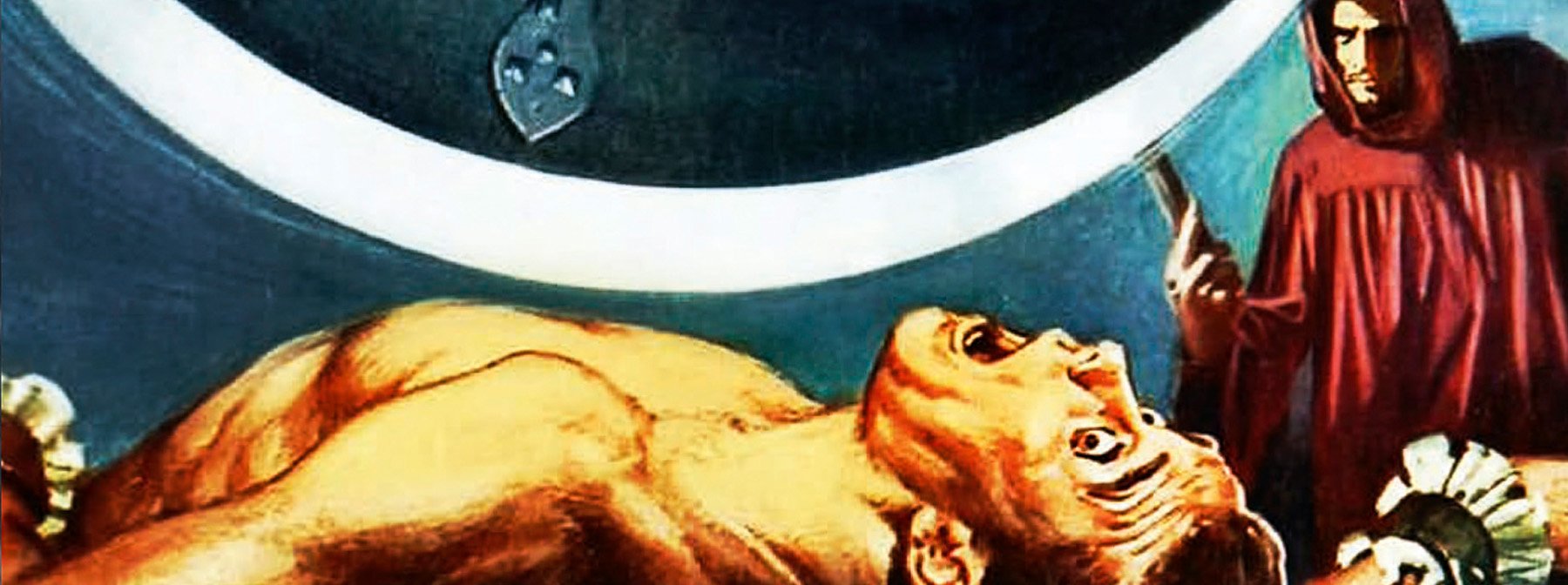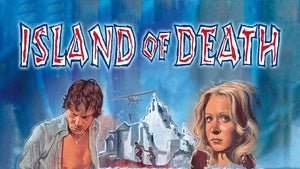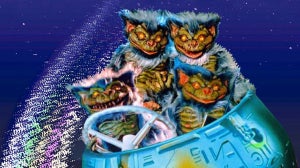
Bullets won’t kill it! Flames can’t hurt it! Nothing can stop it! - so says the tagline on the fabulous poster for 1958’s Earth vs. The Spider. Exchange “bullets” for “budgets” and “flames” for “critics” and it could easily apply to the film’s producers: American International Pictures (AIP). Join us as we introduce this marvellous company, as well as its creators and some of its key pictures.
When Samuel Z. Arkoff and James H. Nicholson formed AIP in 1954, it wasn’t an easy time for independent film exhibitors. After the major studios lost their own cinema chains in a 1948 anti-trust ruling, they focused on more expensive pictures accompanied by new technologies like 3D, widescreen, and stereo sound. Consequently, independent exhibitors were effectively forced to renovate their establishments with expensive new equipment lest they be unable to play new product. Combined with high rental costs (that is, the share of box office profits gained by a film’s distributor), exhibitors across America felt squeezed.
Nicholson’s background in advertising and Arkoff’s in law meant they were ready to seize the opportunity before them. Their idea was simple but genius: modestly-priced pictures made for double bills which could be sold to exhibitors for the price of one film from the majors. The final piece of the puzzle was their audience, the relatively-recent cultural phenomenon largely forgotten by the majors: the teenager.
The following pictures offer a fabulous introduction to AIP for the prospective newcomer, but their production histories also chart the story of this remarkable company.
Day the World Ended (1955)
Day the World Ended is a terrific start to our list because it combines three elements integral to AIP’s early years: Roger Corman, Paul Blaisdell, and a monster. Corman, a young independent filmmaker, had produced a race car movie called The Fast and The Furious in 1954 – the title of which he eventually licensed to Universal in 2001 for their famous film series. AIP were interested in distributing and agreed to pay Corman up front (as opposed to waiting until the film had completed its run in theatres) which allowed him to make more pictures sooner. In turn, this allowed AIP to get off the ground and supply inexpensive product to exhibitors. Day the World Ended wound up being one of these new pictures.
The film opens with ominous narration declaring, “this is TD Day, total destruction by nuclear weapons.” The rest of the film takes place inside a lead-lined valley where a scientist (Paul Birch) and his daughter (Lori Nelson) have stockpiled supplies in their home. As survivors stumble upon them in various states of injury, tensions rise inside the house. To make matters worse, a mutant creature stalks the valley outside.
The monster was created and performed by Paul Blaisdell, AIP’s chief monster-maker in the 1950s. Corman had previously worked with Blaisdell on another early AIP film, the sensationally-titled The Beast with a Million Eyes (1954), and his work under immense budgetary constraints proved his talents. Affectionately named ‘Marty the Mutant’ by its creator, the monster is one of the film’s highlights.
https://www.youtube.com/watch?v=PA1SOb9ufns
I Was a Teenage Werewolf (1957)
As the ‘50s wore on, AIP went from strength to strength releasing horror and exploitation double bills to great success. The culmination of their teen awareness and monster savvy arrived in one of AIP’s very best: I Was a Teenage Werewolf. Michael Landon plays Tony, a troubled young man who explodes into violent rage at the slightest provocation. He’s referred to Dr. Brandon (Whit Bissell), a scientist who uses hypnosis to help him “adjust” to adolescence. Of course, Brandon’s real motive is to test his theory that mankind can be regressed via hypnosis to our former animal self, thus averting our present-day destruction.
Juvenile delinquency was a hot topic in the mid-1950s, and I Was a Teenage Werewolf is often mature and considerate in how it depicts teenage angst. Tony is a troubled boy who ultimately falls prey to predatory adult authority. He is first figuratively monstrous to society, so he is made physically monstrous as punishment. Despite the wild justification for his transformation, the film is striking and often poignant.
https://www.youtube.com/watch?v=PCEM0zBMuUQ
The Pit and the Pendulum (1961)
Following the black-and-white monster cycle of the 1950s, Roger Corman would once again influence AIP’s next steps. Arkoff and Nicholson had approached the producer about doing another pair of black-and-white horrors for $100,000, but Corman instead asked if he could make one film for double the cost in widescreen and colour. This initiated an eight-film cycle between 1960 and 1964 in which Corman adapted the works of Edgar Allan Poe for the screen. These films would also see genre icon Vincent Price become an AIP regular.
The Pit and the Pendulum was the second of AIP’s Poe films after Corman’s House of Usher (1960) performed better than Arkoff and Nicholson had expected. Set in Spain in the 1500s, The Pit and the Pendulum sees Price as Nicholas Medina, the recent widow of Elizabeth Medina (Barbara Steele). When Elizabeth’s brother comes to pay his respects, the atmosphere in the house is sinister. Is Elizabeth still alive as Nicholas believes, or will the terrible history of his father’s torture chamber reveal the truth?
Prior to starting the Poe cycle, Roger Corman had taken an interest in psychoanalysis, going as far as to pay $100 to speak with a Beverly Hills psychiatrist who had written a book analysing the links between humour and horror. Corman’s interest is at the forefront of his version of ThePit and the Pendulum, with Price’s Nicholas unsure of his own consciousness, his mind slipping as the horror of his father’s deeds rises again.
https://www.youtube.com/watch?v=TwbjiQBQFtk
Reptilicus (1963)
Reptilicus is a marvellous giant monster film. A drilling team digs up the remains of a reptilian tail, which eventually regenerates into a complete giant monster: Reptilicus. The beast makes its way through the Danish countryside before ravaging Copenhagen.
The film is an example of how AIP had branched out, looking to overseas productions to import or co-finance. In the case of Reptilicus, American producer Sidney Pink had been convinced to produce further films in Denmark thanks to Henrik Sandberg, the Danish distributor of his last picture, The Angry Red Planet (1959). Pink had entered a four-picture deal with AIP, and having consulted with Nicholson and Arkoff, it was decided that his next film would be about a giant monster wreaking havoc in Denmark. Thus, Reptilicus went into co-production between AIP and Denmark’s Saga Studio.
The production history of Reptilicus is fascinating. Danish and English versions were shot simultaneously. Sidney Pink would shoot a scene in English with the Danish actors (many of whom were cultural icons in their home country, most notably Dirch Passer), before the film's Danish director, Poul Bang, would reshoot with the actors speaking their native language. It was, as Sidney Pink would later recall, “a stupid way to shoot a movie”
Two very different versions of Reptilicus exist: the 1961 Danish cut and the redubbed 1963 AIP version.
https://www.youtube.com/watch?v=OWR7Rqk3kv4
Black Sabbath (1964)
From the late ‘50s onwards, AIP also turned to Italy to import expensive-looking pictures for inexpensive costs with significant profits. As with Reptilicus, AIP didn’t keep itself to just importing, and several Italian co-productions appeared in the early 1960s. In 1961, AIP had imported Mario Bava’s sensational black-and-white horror Black Sunday to great success, and so Black Sabbath went into production as a sort of spiritual successor – one of several co-productions with Italian outfit Galatea.
Black Sabbath is a taut anthology featuring three horror stories. In The Telephone, a woman is menaced by repeated calls from her former pimp. The Wurdulak sees Boris Karloff return to his family home after apparently killing the title creature, a ghoul who feeds on the blood of those it loves. The last – and best – story is A Drop of Water, which follows a nurse who steals a ring from her recently-deceased patient and is haunted as consequence.
The Italian and American versions of Black Sabbath are quite different. In this author’s opinion, the AIP cut is superior. The English-language version has Boris Karloff introduce the picture, the unique timbre of his voice instantly setting the perfect tone. The AIP version also re-arranges the stories so that A Drop of Water goes first, The Telephone second, and The Wurdulak last.
https://www.youtube.com/watch?v=t7MyJMlOpdE
Wild in the Streets (1968)
Wild in the Streets perhaps demonstrates AIP’s finger on the cultural pulse at its finest. The film asks the question every generation poses: what if young people were in charge? Wild in the Streets follows Max Frost, a millionaire 20-something rockstar whose public image sees him catapulted to the highest office in the land. As President, Frost and his entourage put everyone over 30 in LSD camps, ruling America with all the political nuance of a cartoon villain. The film is ultimately flawed in that its depiction of youth rule is obviously tinged with conservative anxiety. The radical value of its fictional revolution is also undercut by the fact that its leader is a wealthy white man.
Nevertheless, Wild in the Streets is a remarkable cultural artefact of generational clash from a decade in part defined by that conflict. Moreover, the sheer fact that the film depicts such wild ideas is a testament to AIP’s showmanship. At the very least, the film has a fabulous original song, The Shape of Things to Come, which received an equally fabulous cover by the Ramones in 1993.
https://www.youtube.com/watch?v=k4KKD_SuLRY
The Abominable Dr. Phibes (1971)
One of AIP’s most peculiar releases given its modus operandi was a 1970 adaptation of Wuthering Heights. Though the film wasn’t a great success, director Robert Fuest had impressed Nicholson and Arkoff, paving the way for his involvement in arguably one of Vincent Price’s best horror films. The Abominable Dr. Phibes is a tour de force of gorgeous production design, sharp wit, and memorable set pieces. Price plays the title role, the marvellous Dr. Anton Phibes, seeking revenge against the doctors who couldn’t save his wife’s life. He’s a remarkable villain, at once repulsive with his elaborate murders but also strangely sympathetic; the love for his deceased wife drips with gothic brilliance. Perhaps unsurprisingly, the film was successful enough to produce a sequel a year later: Dr. Phibes Rises Again.
Dr. Phibes was one of the final films James H. Nicholson was involved with. He would leave AIP in 1972 for a multi-picture deal with 20th Century Fox. However, Nicholson didn’t get to complete his deal; cancer ended his life at age 56.
https://www.youtube.com/watch?v=sxnr9xycVLo
The Amityville Horror (1979) and the end of AIP
It seems fitting that one of AIP’s last hurrahs – and one of its most successful films – was a horror picture. The Amityville Horror remains as effective as ever, a haunted house horror triumph. Starring Margot Kidder and James Brolin, The Amityville Horror tells the supposedly true story of the haunting of the Lutz family, whose new home seems possessed by several demonic entities.
Horror had changed by 1979, and the days of Dr. Phibes seemed quaint next to mainstream hits like The Exorcist (1973) and The Omen (1976), as well as independent successes like Halloween (1978). Nevertheless, The Amityville Horror showed AIP as on-the-pulse as ever. Indeed, Amityville pulled in $86 million on a $4 million budget. By contrast, 20th Century Fox’s Alien – released the same year – grossed $106 million on a budget of $11 million. Not a bad achievement for AIP to go out on.
Indeed, AIP had much to be proud of. Their horror, exploitation, and teenage-oriented films had captured media sensation on meagre budgets, and many of their pictures stand the test of time. However, around the time of Amityville’s production, Sam Arkoff was in talks to merge AIP with Filmways. Arkoff released a handful of new pictures under the merger before finally selling his stock for $4 million in 1980. The film business had changed, James H. Nicholson was long gone, and Arkoff was moving on. Although he would release a smattering of pictures throughout the 1980s via Arkoff International Pictures – including cult classics like Q: The Winged Serpent (1985) – it was time for Arkoff to call it quits.
So, dear reader, take another look into the wild and wonderful world of American International Pictures. These eight films serve as a brief glimpse into the striking variety of pictures AIP produced, with a great deal more waiting to be rediscovered.

Related Articles








